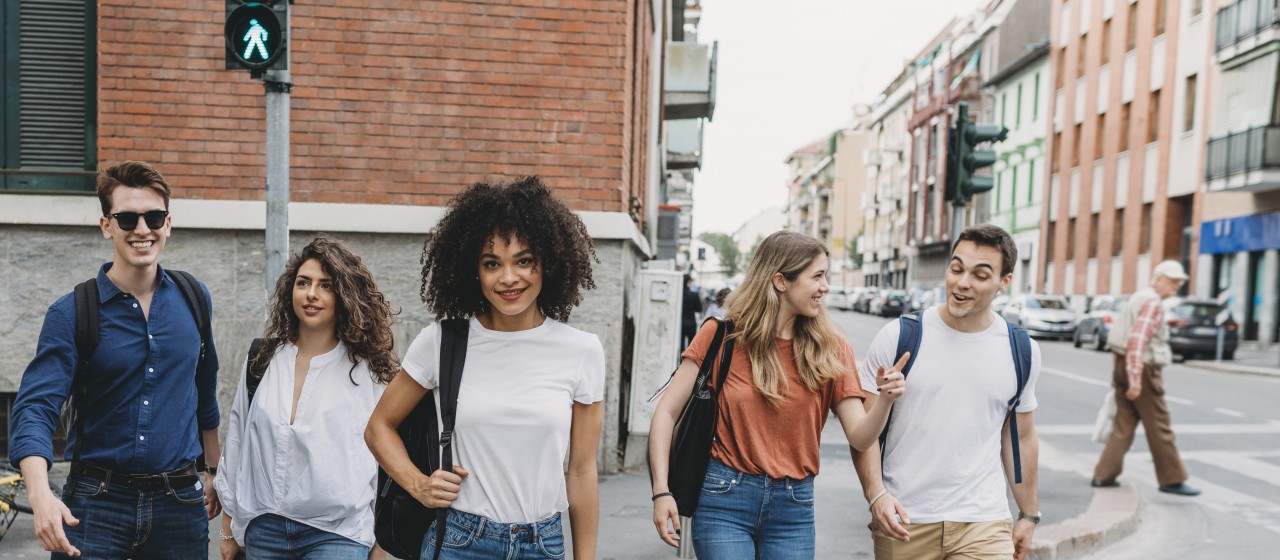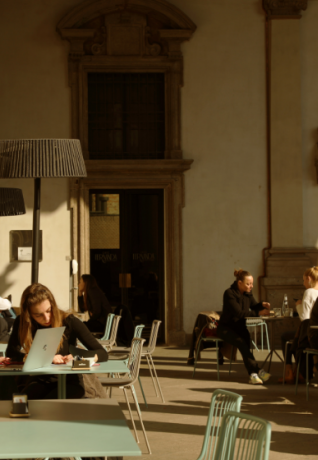Great Popular Neighborhoods in Milano

Milano: modern, classy, beautiful, and a little crazy.
It’s nearly the perfect European city.
If you wonder which are the best city districts for you to live in, we suggest to go beyond the inner circle of your university campus, maybe a bit far from the city center. Thanks to the efficient public transport system, you will find out that moving from one place to the other in Milano is easy and fast.
Explore the most popular neighborhoods and if you need advices on renting an apartment here is our guide.
NoLo stands for North of Loreto square. This area, located between the Central Station and Parco Trotter, has undergone a dramatic transformation over the last decade, becoming the neighborhood of choice for young creatives and graffiti artists, thanks to its bicycle shops, art galleries, vegan cafés, alternative bars and cinemas, ethnic shops and restaurants, and the best covered market in Milano. Tactical urbanism has made this liberty-era neighborhood pedestrian- and bike-friendly, with the popular Piazza Arcobaleno (formerly Piazza Spoleto) and exquisite Piazza Morbegno being areas of attraction for the locals.
Nolo is well connected to the rest of the city (M1/M2 Loreto, M2 Caiazzo, M2/M3 Centrale), but the best way to get there is to take the tram #1 to Piazza Morbegno.
Bicocca used to host the giant Pirelli tire factories and more heavy industries. Over the last three decades, it has become the home of the University of Milano Bicocca, which offers a whole range of public higher education, including medicine, sociology, statistics, and economics. Bicocca is also a stylishly modern neighborhood, complete with a movie mall, a big auditorium (Arcimboldi Theater), and a major center for contemporary art (Pirelli Hangar Bicocca,). The lilac subway line (M5), provides fast access to the whole area, which is huge and can be observed from above from Collina Dei Ciliegi, one of Milano's only two hills (the other one is Montagnetta, also artificial, near Lampugnano and San Siro).
From Bicocca, it's easy to foot or cycle to Parco Nord, the biggest green lung of the city, covering an area of 7,9 square kilometers. This is where the Northern Milanese like to do their running or picnicking, perhaps ending the day at Sun Stracc, an open-air bar by a little lake, next to the terminus of tram #4 to Niguarda, a truly Milanese neighborhood with a strong civic life, worth a visit in its own right (walk down Via Ornato).
Bicocca district hosts distinct modern architectures. The campus has a life of itself, animated by coffee shops, shopping centers, and popular cultural spots like one of the most famous city museum of contemporary art. The museum also organizes bicycle tours of the district showcasing the former industrial zone as a vibrant arts scene. The Arcimboldi Theatre is also hosting concerts, musicals, and shows.
Porta Romana and the adjoining Piazzale Lodi area is one Milano's emerging neighborhoods for daily living and nightlife. Populated by middle-class professionals and college students, especially from the nearby Bocconi University and the IED design school, the area has undergone a great transformation in recent years, which will be completed by the construction of the Olympic Village for the 2026 Winter Games in the midst of the old railway tracks area around Piazzale Lodi. Developed south of the like-named 1596 gate along the Spanish walls (from there you could take the road to Rome), the neighborhood contains a food district, with several specialty eateries and wineries, bookstores and cafés, and the lively street market in via Crema (Fridays: metro M3 P.ta Romana) and has become the proud home of Fondazione Prada, a vast complex that hosts a truly transnational cultural institution for contemporary visual arts. The MUBA located at nearby Rotonda della Besana, a jewel of Renaissance architecture, offers an original museum for kids under the age of 12. Several theaters add to the cultural sophistication of the area, including Teatro Franco Parenti, a must if you want to see the staging of modern and classical plays. For jogging, locals like to do their running at Parco Ravizza, on the other side of the road from the Bocconi Campus. The park also features a public indoor swimming pool.
There is nothing more Milanese than a night out at the Navigli. These are freshwater canals that come into the city from the south, Naviglio Grande and Naviglio Pavese, and merge into the Darsena by Porta Ticinese, one of the main gates of access to the city. Many young people come here to live and have fun, because when the night falls, it's aperitivo big time! It also helps that four Milanese universities - Bocconi, Cattolica, IULM, and NABA - are within walking distance, so the area teems with young people. The area can be reached by either tram (lines #3, 9, 10, 14) or subway (M2 P.ta Genova). The area behind Porta Genova (via Tortona and via Savona) is home to many designers' studios and fashion showrooms and hosts the Fuorisalone each year, a boon for the young creative class attracting talent from all over the world.
Città Studi is home to all the science, engineering and architecture universities of Milano. To reach the area take the green line of the subway (stops: M2 Piola, M2 Lambrate FS). Piazza Leonardo da Vinci is the heart of the area, because that's where the Politecnico is headquartered. Colloquially known as PoliMi, it has trained engineers and architects from all over the world for over a century. All around, there are also the departments of Physics, Biology, Pharmacy, Agriculture, Pharmacy, of the University of Milano, so don't be surprised that many of the people in the neighborhood are either students or faculty. Casa dello Studente is a historical Politecnico student dorm, and most of the area was built in the 1930s.
Città Studi is replete with pubs, pizzerias, ice cream shops and sports facilities catering to students. Birrificio Lambrate, the oldest microbrewery in the city, is a great place for a media chiara after class.
Bovisa is a former working-class and industrial district that has been transformed by the coming of the Politecnico in the area right by the Bovisa railway station that takes you to Cadorna Station and downtown Milano in 10 minutes (and to Centrale Station and Malpensa Airport, too). Its case di ringhiera (railing houses) offer affordable and picturesque accommodation to a growing population of students, in this hard-core Milanese 'hood that extends to Piazza Bausan and Via Imbriani. The old industrial lots of the area have been turned into diners, cafeterias and trendy nightlife venues such as Spirit de Milan. The Bovisa campus hosts the PoliMi Department of Design, as well as Management, Energy and Aerospace. On the other side of the station there is the mysterious Goccia (the Drop), with its trees and dismissed gasometres, and then the Villapizzone station, a whole separate district with green parks and children's schools which has developed around the historic villa. Then walk to Piazza Pompeo Castelli and jump on the tram #19 which has its terminus in the luscious rotunda. It will take you all across the city -up to Lambrate Station in Città Studi. The old factories of this area have all been little by little turned into trendy nightlife venues such as restaurants, theaters or university accommodations.
The Trenord trains from Bovisa station are also a very fast connection to the city center.
The Porta Nuova district is Milano's urban future made real. The Unicredit and Bosco Verticale skyscrapers dominate a brand-new district, which straddles across the Brera and Isola neighborhoods. The Gae Aulenti Plaza (M2/M5 Garibaldi FS) is the symbol of Milano's new-found dynamism in the 2010s, giving the city its current skyline and hosting a crop of international brands, including Nike and Tesla: is it Manhattan or Milano? The Lombardy Region has also built its headquarters in the area, with the Palazzo Lombardia skyscraper and complex (M4 Isola). The Milano Library of Trees (BAM) is the name given to the flowery park that lets you walk from Porta Nuova to Porta Garibaldi and Isola, where we suggest you hang out in the freshly remade and pedestrianized square of Piazza Archinto. And if you walk down Corso Como, you'll get to Piazza XXV Aprile and its panoply of restaurants, food stores, coffee shops and cocktail bars. Beyond there, walk down the long Corso Garibaldi, which is one of Milano's most characteristic streets, full of shops and culture. You'll end at the Strehler Theater of Europe. At the opposite end of Corso Como, there is the Garibaldi railway station, which is a major transportation hub in its own right, linking the whole region and several national destinations, as well as the TGV train to Paris.
Modernity melts with the epic 20th-century architecture of Stazione Centrale, the city’s main train station. It is one of the most developed Milano work district. If you love living in the centre of the city, this is your go-to district. It’s also convenient to live here to be on time for the train whenever you’re off to visit other Italian cities! If you study in Università Statale, catch the yellow line metro from Centrale and after 5 stops get off in Missori. To get to Città Studi and Politecnico it’s even closer, just 3 stops on the green line that - in the opposite direction - also brings you to IULM, Università Cattolica.
Bande Nere – Inganni is a residential area close to Lorenteggio. Green parks, supermarkets, and restaurants blossom here. It’s the perfect neighborhood to relax and find quiet spots to study. The Red line of the subway takes you to Duomo in less than 15 minutes.
In October 2020, Porta Venezia was ranked among the forty coolest neighborhoods in the world by London's Time Out magazine. The Porta Venezia district in Milano has a long and fascinating history. It became associated with modernity, architecture, and shopping, during the age of Art Nouveau and Futurism in the early 1900s. Since the 1960s, it has been home to the large Eritrean and Ethiopian communities of Milano. Since the 1990s, it has become the queer epicenter of the city, hosting the nation's largest LGBTQ* Pride Parade every year.
Porta Venezia is near the center of Milano and is well-connected to the rest of the city by public transit. The Red line of the metro and the Passante suburban rail link both have stations at P.ta Venezia. And if you want to enjoy the first public park (1784) in the history of Milano, the Giardini of Porta Venezia, make sure you get off at Palestro, also on the M1 subway line. You'll find the Museum of Natural History and the Planetarium, the kids' merry-go-round, an outdoor bar where people play chess, and that's only the beginning of it.
For ethnic food, a drink, shopping, or culture, you're likely to end up in Porta Venezia during your stay in Milano.

 Log in
Log in


